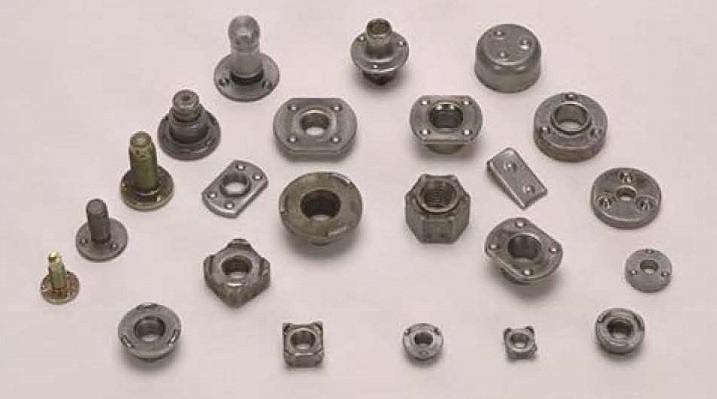This question should be further elaborated to include how close should the fixture bottom support be to the outside of the nut wall? Secondly which is preferred a ball end shaped rod or a threaded bold for even consistent force application.

ASSORTED WELD NUTS
This is a question in two parts – Fixturing the assembly to be evaluated, and the push off tooling used to apply force directly against the actual weld nut.
Fixturing
Your question mentions the need to evaluate a square nut, but the thought process is really the same for any weld nut push-off test. The supporting bottom-end tooling (think a tube, or socket, etc.) needs to be as close as practical to the weld nut. The only caveat is the actual act of pushing off the weld nut must not be impeded. The real concern is the separation of a small portion of the weld nut (think a single projection, or some part of a ring) causing the weld nut to tilt sideways. When it does tilt, it might get wedged against the bottom-end tooling. If force is still being applied while the weld nut is wedged, this mechanical lock may result in an artificially high push-off value. This means that the height of the weld nut being pushed off can have an impact on the needed clearance. Also, the strength and/or gauge of the material the nut is welded to can affect the required tooling. And as one would surmise, the greater the value for either, the less critical the need to be as close to the weld nut as possible.
Push-Off Tooling
As can be discerned from above, the goal of the destructive push-off test is to apply a load that is normal to the nut, and determine the amount of force required for separation to occur. In some cases, the weld nut is threaded and a bolt can be inserted, thus providing a means to push against the part. In those cases where the nut is not threaded, some sort of intermediate mechanical device (think a pin or rod, etc.) is needed in order to apply the load to the nut. These intermediate devices may be attached to the prime mover responsible for applying the load, or carefully inserted between the nut and prime mover as a separate entity for each test.
Regardless of the method employed, the idea is to ensure, as much as possible, that any load applied to weld nut is done in a safe and consistent manner. With that in mind, the repeatability and safety of pushing against a bolt when threads are available, make it, from my perspective, the far superior choice.
References: AWS Welding Journal: January & March 2011
Q & A “Quality of Forged Projection Weld Nuts” by DONALD F. MAATZ JR.
Technical Input by - DONALD F. MAATZ Jr.

